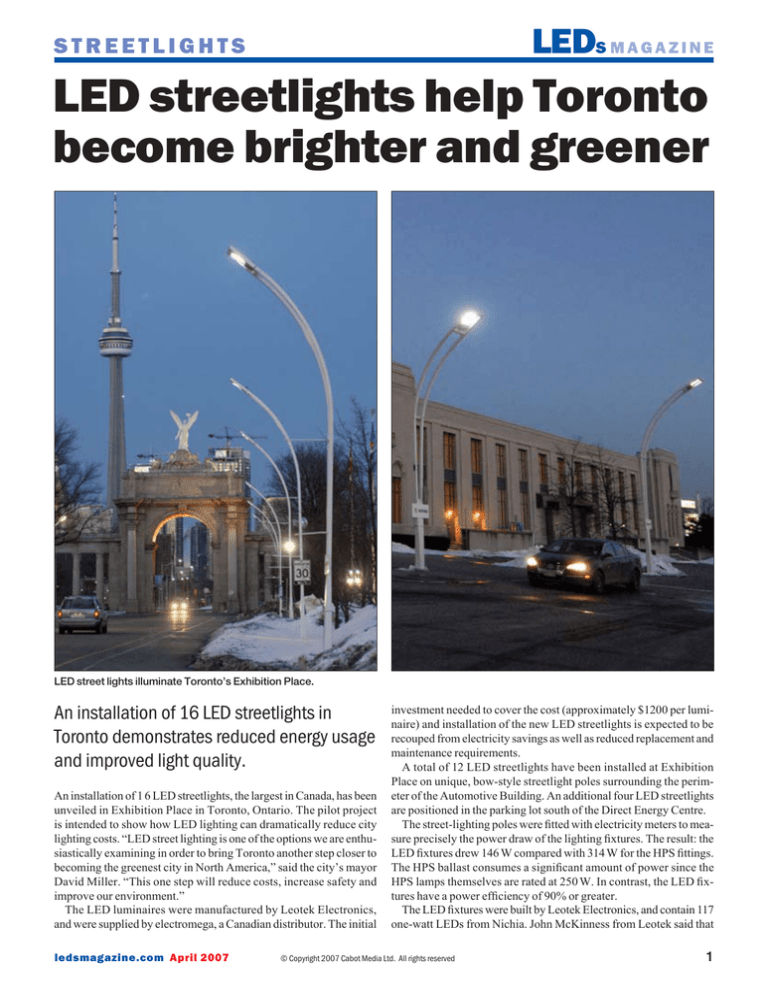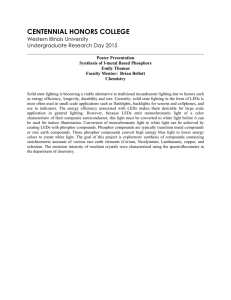
LEDs m a g a z i n e
Streetlights
LED streetlights help Toronto
become brighter and greener
LED street lights illuminate Toronto’s Exhibition Place.
An installation of 16 LED streetlights in
Toronto demonstrates reduced energy usage
and improved light quality.
An installation of 1 6 LED streetlights, the largest in Canada, has been
unveiled in Exhibition Place in Toronto, Ontario. The pilot project
is intended to show how LED lighting can dramatically reduce city
lighting costs. “LED street lighting is one of the options we are enthusiastically examining in order to bring Toronto another step closer to
becoming the greenest city in North America,” said the city’s mayor
David Miller. “This one step will reduce costs, increase safety and
improve our environment.”
The LED luminaires were manufactured by Leotek Electronics,
and were supplied by electromega, a Canadian distributor. The initial
ledsmagazine.com April 2007
investment needed to cover the cost (approximately $1200 per luminaire) and installation of the new LED streetlights is expected to be
recouped from electricity savings as well as reduced replacement and
maintenance requirements.
A total of 12 LED streetlights have been installed at Exhibition
Place on unique, bow-style streetlight poles surrounding the perimeter of the Automotive Building. An additional four LED streetlights
are positioned in the parking lot south of the Direct Energy Centre.
The street-lighting poles were fitted with electricity meters to measure precisely the power draw of the lighting fixtures. The result: the
LED fixtures drew 146 W compared with 314 W for the HPS fittings.
The HPS ballast consumes a significant amount of power since the
HPS lamps themselves are rated at 250 W. In contrast, the LED fixtures have a power efficiency of 90% or greater.
The LED fixtures were built by Leotek Electronics, and contain 117
one-watt LEDs from Nichia. John McKinness from Leotek said that
© Copyright 2007 Cabot Media Ltd. All rights reserved
LEDs m a g a z i n e
Streetlights
since these have been around longer and there is more life-testing data
available. “Using a smaller number of LEDs driven at higher power
would change the arrangement of LEDs and require a different reflector to meet the light distribution pattern,” he says.
Light output and quality
The launch ceremony on 28 February provided an excellent opportunity for observers to study and compare lighting from LED fixtures on
one side of a street and conventional HPS fixtures on the other. Peter
Strasser of the International Dark-Sky Association was there, and
reported a very positive response to the new lights. “All the observers said that the LED lighting appeared brighter, and enabled people
and objects to be viewed much more clearly,” said Strasser. “In fact,
I took measurements with a simple light meter, and the LEDs produced a little under half the number of foot candles that came from
the HPS lamps.”
So, while drawing less than half the power of the HPS fixtures, and
producing half the measured light output, the LEDs provide improved
light quality as far as the observers were concerned.
The reason for this relates to the spectrum of LED light, which
has significant blue content (most white LEDs are manufactured by
combining a blue-emitting LED chip with a yellow-emitting phosphor material). “In dim lighting conditions, the eye is more sensitive
to the blue end of the spectrum and can detect more light,” explains
Strasser. While LEDs provide a better match with mesopic vision,
which is prevalent under dim lighting conditions, the standards and
codes that determine light distribution patterns are written in terms
of photopic lumens. This favours low-pressure sodium light, which
matches the eye’s photopic response. There are suggestions that the
standards should be revisited and possibly rewritten to take mesopic
vision into account, but, of course, this will take a long time.
Strasser says that LED lighting is of considerable interest to the
Dark-Sky Association, which seeks to reduce light pollution and
preserve dark-sky heritage through good lighting design. By placing
light where it is needed, when it is needed, this approach saves light
and reduces energy expenditure. “LEDs provide very good control,
and are excellent for reducing wasted light,” says Strasser. “They also
provide very good cut-off at the edge of the distribution.”
A conventional luminaire containing a high-pressure sodium (HPS)
lamp, and Leotek’s LED street light.
these LEDs provide “the highest efficacy (lm/W) among production
LEDs, and very good reliability”. Leotek’s luminaires contain a built-in
heat sink to deal with thermal issues, and have a five-year warranty.
The LED luminaires are designed as direct replacements for conventional cobra-head fittings, and provide a type-II roadway distribution. IES files for Leotek’s SL-250 luminaire, the type used in
Toronto, show a downward flux distribution of 1202 lm on the house
side and 3505 lm on the street side for a total of 4708 lm, which puts
the overall fixture efficacy at around 32 lm/W. Very significantly, the
upward flux distribution is zero, while cobra-head fittings containing
other types of lamp can typically waste as much as 30% of their light
output in the upwards direction.
McKinness says that Leotek currently uses one-watt class LEDs
Energy conservation
Toronto’s LED project was organized by greenTbiz, a program developed by the Toronto Association of Business Improvement Areas
(TABIA) to assist businesses and property owners with energy conservation and environmental improvement.
The City of Toronto has about 160 000 streetlights and if these were
all converted to LEDs the city could save $6 million a year in electricity costs and reduce greenhouse gas emissions by 18 000 tonnes, the
equivalent of removing more than 3600 cars from the streets. The pilot
program will continue through 2007 to test public acceptance, durability, light performance and weather resistance, and additional pilot tests
●
of LED technology are planned in other areas of Toronto.
Links
Leotek Electronics: www.leotek.com
International Dark-Sky Association: www.darksky.org
‘On the verge: LEDs ready to challenge incumbent light sources in
the street lighting market’ LEDs Magazine October 2006
www.ledsmagazine.com/features/3/10/4
© Copyright 2007 Cabot Media Ltd. All rights reserved
ledsmagazine.com April 2007





